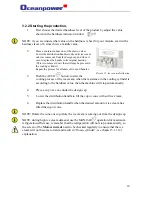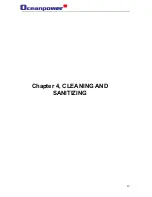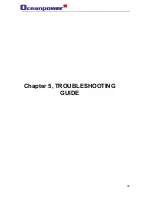
•
The voltage is above 242 V, high-voltage protection.
•
The compressors temperature is high, then PTC protective device will stop the
compressor, to let it cool down for 10 minutes.
NOTE: the machine can be returned into normal operating condition manually by
pressing the Stop button. Before you restart the machine, please ensure that the
problem been solved.
NOTE: If the machine often enters the protective mode, it is recommended that a
manostat (5KVA) is purchased and used to stabilize the voltage.
5.1.3 The machine do not start.
Cause:
1.
The auto-protection of the machine is triggered.
2.
Machine is not connected to the main power source.
Solution:
1.
Ensure that the power supply is normal and the voltage is within the permitted
range.
2.
Control that the power plug is well connected and that the emergency or the
power switch is in operating position.
5.1.4 The machine do not stop automatic during AUTO condition.
Cause:
1.
Because of to little ice cream mixture in the cooling cylinder,
2.
That the surrounding temperature is to high (>38 ºC)
Solution:
1.
Control that the little hole in the air tube is in downward position
2.
Try to lower the surrounding temperature.
NOTE: These two conditions may results in that the necessary resistance in the cooling
cylinder cannot be reached and the machine will not stop.
5.1.5 The machine will not stop when pushing STOP button.
Cause:
1. The springy touch pole or its spring has been deformed or damaged.
Solution:
1. Repair or change the pole or its spring.
5.1.6 The ice cream is too hard or too soft.
Cause:
1.
The hardness value is not properly set.
2.
The ice cream mix has not been properly prepared.
3.
The ice cream mix that is used is not suitable for this machine.
4.
The ice cream is distributed before the refrigeration cycle is finished,
5.
The amount of soft ice cream in the cooling cylinder is to little.
26
Summary of Contents for OPF130
Page 5: ...Chapter 1 General information 5...
Page 11: ...Chapter 2 INSTALLATION 11...
Page 15: ...Chapter 3 OPERATING INSTRUKTION 15...
Page 19: ...Chapter 4 CLEANING AND SANITIZING 19...
Page 24: ...Chapter 5 TROUBLESHOOTING GUIDE 24...
Page 28: ...2 Follow the mixing rate according to the manufacturer 3 Try to always use fresh mix 28...




































